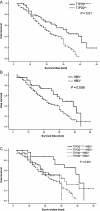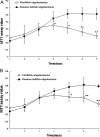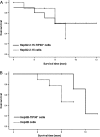Association of TIP30 expression and prognosis of hepatocellular carcinoma in patients with HBV infection
- PMID: 27418384
- PMCID: PMC5055146
- DOI: 10.1002/cam4.728
Association of TIP30 expression and prognosis of hepatocellular carcinoma in patients with HBV infection
Abstract
Altered expression of TIP30, a tumor suppressor, has been observed in many cancers. In this study, we have evaluated the expression of TIP30 in the tissues of 209 hepatocellular carcinomas (HCC) and their adjacent tissues by using a high-density tissue microarray, and analyzed its correlation with the clinical pathological parameters of the patients. The results revealed negative or weak expression of TIP30 in 43.5% (91/209) of the HCC tissues, and in only 27% (56/209) of the adjacent tissues. The expression level of TIP30 in HCC was inversely correlated with serum alpha-fetoprotein (AFP) levels, HBV infection, and tumor differentiation. Multivariate analysis for survival indicated that serum HBV infection was the most significant predictor of poor prognosis in HCC (P = 0.0023), and TIP30 expression and tumor differentiation were also independent indicators in this respect (P = 0.0364 and P = 0.0397, respectively). Patients with medium or high expression levels of TIP30 (TIP30(++/+++) ) had a better 5-year overall survival rate than those with low/negative (TIP30(+/-) ) expression (P < 0.001). TIP30(+/-/) HBV(+) patients had the worst 5-year overall survival rate, whereas TIP30(++/+++) /HBV(-) patients had the best. To further explore the correlation between TIP30 and HBV infection in HCC, HBV(+) hepatoblastoma cell-line HepG2 2.2.15 and HCC cell-line Hep3B were used. Upon silencing of HBV, we observed an upregulation of TIP30 and decreased cell proliferation. In the in vivo studies, we found that the mice inoculated with HepG2 2.2.15 cells with HBV silencing had a prolonged tumor latency and a longer life span, as compared to the control mice inoculated with untreated control cells. In conclusion, the results suggest that downregulation of TIP30 may result from HBV infection, and subsequently promotes the progression of HCC.
Keywords: HBV; Survival; TIP30; hepatocellular carcinomas; tumor suppressor.
© 2016 The Authors. Cancer Medicine published by John Wiley & Sons Ltd.
Figures






Similar articles
-
miR-106b promotes cancer progression in hepatitis B virus-associated hepatocellular carcinoma.World J Gastroenterol. 2016 Jun 14;22(22):5183-92. doi: 10.3748/wjg.v22.i22.5183. World J Gastroenterol. 2016. PMID: 27298561 Free PMC article.
-
Methylation of Tip30 promoter is associated with poor prognosis in human hepatocellular carcinoma.Clin Cancer Res. 2008 Nov 15;14(22):7405-12. doi: 10.1158/1078-0432.CCR-08-0409. Clin Cancer Res. 2008. PMID: 19010857
-
Icaritin-induced immunomodulatory efficacy in advanced hepatitis B virus-related hepatocellular carcinoma: Immunodynamic biomarkers and overall survival.Cancer Sci. 2020 Nov;111(11):4218-4231. doi: 10.1111/cas.14641. Epub 2020 Sep 24. Cancer Sci. 2020. PMID: 32889778 Free PMC article.
-
Hepatitis B Virus Pre-S Gene Deletions and Pre-S Deleted Proteins: Clinical and Molecular Implications in Hepatocellular Carcinoma.Viruses. 2021 May 8;13(5):862. doi: 10.3390/v13050862. Viruses. 2021. PMID: 34066744 Free PMC article. Review.
-
TIP30: A Novel Tumor-Suppressor Gene.Oncol Res. 2014;22(5-6):339-48. doi: 10.3727/096504015X14424348426116. Oncol Res. 2014. PMID: 26629947 Free PMC article. Review.
Cited by
-
Absence of HTATIP2 Expression in A549 Lung Adenocarcinoma Cells Promotes Tumor Plasticity in Response to Hypoxic Stress.Cancers (Basel). 2020 Jun 11;12(6):1538. doi: 10.3390/cancers12061538. Cancers (Basel). 2020. PMID: 32545251 Free PMC article.
-
Novel oncogenes and tumor suppressor genes in hepatocellular carcinoma.Liver Res. 2021 Dec;5(4):195-203. doi: 10.1016/j.livres.2021.06.001. Epub 2021 Jun 23. Liver Res. 2021. PMID: 34900376 Free PMC article.
-
Expression of the Wnt ligands gene family and its relationship to prognosis in hepatocellular carcinoma.Cancer Cell Int. 2019 Feb 15;19:34. doi: 10.1186/s12935-019-0743-z. eCollection 2019. Cancer Cell Int. 2019. PMID: 30814912 Free PMC article.
-
The prognostic value of CYP2C subfamily genes in hepatocellular carcinoma.Cancer Med. 2018 Apr;7(4):966-980. doi: 10.1002/cam4.1299. Epub 2018 Feb 26. Cancer Med. 2018. PMID: 29479826 Free PMC article.
-
Low expression of VSIG4 is associated with poor prognosis in hepatocellular carcinoma patients with hepatitis B infection.Cancer Manag Res. 2018 Sep 20;10:3697-3705. doi: 10.2147/CMAR.S165822. eCollection 2018. Cancer Manag Res. 2018. PMID: 30288101 Free PMC article.
References
-
- Jemal, A. , Bray F., Center M. M., Ferlay J., Ward E., and Forman D.. 2011. Global cancer statistics. CA Cancer J. Clin. 61:69. - PubMed
-
- Chemin, I. , and Zoulim F.. 2009. Hepatitis B virus induced hepatocellular carcinoma. Cancer Lett. 286:52–59. - PubMed
-
- Yuen, M. F. , Hou J. L., and Chutaputti A.. 2009. Hepatocellular carcinoma in the Asia pacific region. J. Gastroenterol. Hepatol. 24:346–353. - PubMed
Publication types
MeSH terms
Substances
Grants and funding
LinkOut - more resources
Full Text Sources
Other Literature Sources
Medical

